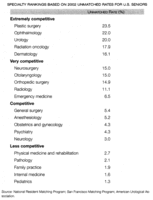|
Monday, August 29, 2005
Back in December '04 UCLA Law Professor Richard Sanders published A Systemic Analysis of Affirmative Action in American Law Schools in the Stanford Law Review which detailed the costs to African-American students of being recipients of Affirmative Action (see here and here for the Cliff Notes versions.) As you can imagine this set off a fire storm of protest, similar in tone, though subdued in fury, to what followed the publication of Rushton and Jensen's paper Thirty Years of Research on Race Differences in Cognitive Ability. Critics lined up to take their shots at Sanders. A good summary of the ensuing battle can be found at the Volokh Conspiracy, here and here (Be sure to read the comments.)
As with Ruston & Jensen's paper, the controversy that followed Sanders was a clear case of conflicting Axioms with many of the rebuttals arguing from the Axiom of Equality, the Axiom of Proportionalism and Axiom of Social Justice, and were primarily worried about the decreased African American presence in law schools that would result if Affirmative Action was eliminated. In reading many of these rebuttals I was struck by the game theoretic aspects which argued that if Affirmative Action was eliminated that many African-American students would transfer their ambitions to other Professional Schools that still employed Affirmative Action policies. The critics argued that Law Schools shouldn't abandon the crutch they've provided to minority students thereby foreclosing the prospect of losing these unqualifed students to rival faculties. The critics seemed to completely miss that Sanders was arguing from the Axiom of Merit, which he felt trumped the existing policies of the Law Schools. After reading through the back and forth volleys I got to wondering why no similar study had been conducted on the effects of Affirmative Action within the medical community. Afterall, the stakes are certainly greater in that a medical student's performance impacts on the health of patients, rather than simply their well-being (civil law) or freedom (criminal law.) What I really wanted to see was how medical malpractice suits were broken down by race of the physician but I couldn't find any data at all. If anyone has access to such data, please leave a comment or e-mail me with the particulars. I'm guessing the data is proprietary to insurance companies and is probably essential in determining insurance rates. After reading some of the data from the National Medical Association, which represents the interests of African-American physicians, it's clear that obtaining malpractice insurance is a significant problem for its members, but considering that we're in the middle of a malpractice crisis, it's imposible to ascertain whether African-American physicians' rates, and difficulty in obtaining insurance, are any different from the physican community as a whole. However, even without the medical malpractice data, the consequences of Affirmative Action are evident in how minorities perform in medical school and in subsequent licensing examinations:
It appears that Affirmative Action's lenient admission standards weeds out the weaker candidates before the time for placement through the National Resident Matching Program sifts and sorts the nation's medical school graduates and places them into residency programs. Surprisingly I didn't find any declarative statements that the program grants any preferential treatment to minorities, so if this is a true condition, we'd expect to see more of a merit-based sorting based on the competitiveness of the various disciplines. It's frustrating that the data I'm seeking is not available, for I think it would be informative to get a racial breakdown of medical specialties and compare the results to the difficulty of winning admission into the medical specialties.  I did find this breakdown of Black Physicians in New Orleans, and using the competitiveness data above, 9% belong to the Extremely Competitive specialities, 15% to the Very Competitive, 30% to the Competitve and 46% to the Less Competitive. Again, the corresponding data from the medical community as a whole is difficult to extrapolate without access to more data sources. Here is a datasource on State Health Facts that some may find useful. So what is the ripple effect of admitting minority students to medical school under preferential quotas? The evidence is clear that a sizable portion of minority students simply won't get licensed to practice. Of those that do get licensed, I'd dearly like to know how well they perform without institutional favoritism shielding them from the full effects of competition and how well they adhere to professional standards. Once out of medical school, the results of Affirmative Action can have real consequences:
We also see problems with institutional slipping of standards, as Godless noted the problems facing two black medical schools:
With the consequences of incompetence being so much greater in the field of medicine than in law, a study similar to the one conducted by Professor Sanders is urgently called for. If the Axiom of Merit loses ground to the Axiom of Proportionalism, we could see calls for increased enrollment under preferential guidelines for minority students as reported in The Right Thing to Do, The Smart Thing to Do: Enhancing Diversity in Health Professions by the National Academies Press:
Note how Asians are Honorary Whites in that report. It's difficult to model how reduced standards for minority students can be ameliorated if they are not as prepared as their colleagues for the rigors of medical school, have higher failure rates during their education, have a more difficult time passing licensing examinations, and with some schools at least, have a disproportionate presence in disciplinary hearings. Are we to believe that simply practicing their craft on innocent patients will over time increase their competence to the same level of their colleagues who weren't admitted under preferences schemes? Related: What do you call a black doctor? and ER Meets Reality and Bell Curve For Doctors |



